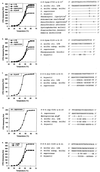Quantification of syntrophic fatty acid-beta-oxidizing bacteria in a mesophilic biogas reactor by oligonucleotide probe hybridization
- PMID: 10543784
- PMCID: PMC91642
- DOI: 10.1128/AEM.65.11.4767-4774.1999
Quantification of syntrophic fatty acid-beta-oxidizing bacteria in a mesophilic biogas reactor by oligonucleotide probe hybridization
Abstract
Small-subunit rRNA sequences were obtained for two saturated fatty acid-beta-oxidizing syntrophic bacteria, Syntrophomonas sapovorans and Syntrophomonas wolfei LYB, and sequence analysis confirmed their classification as members of the family Syntrophomonadaceae. S. wolfei LYB was closely related to S. wolfei subsp. wolfei, but S. sapovorans did not cluster with the other members of the genus Syntrophomonas. Five oligonucleotide probes targeting the small-subunit rRNA of different groups within the family Syntrophomonadaceae, which contains all currently known saturated fatty acid-beta-oxidizing syntrophic bacteria, were developed and characterized. The probes were designed to be specific at the family, genus, and species levels and were characterized by temperature-of-dissociation and specificity studies. To demonstrate the usefulness of the probes for the detection and quantification of saturated fatty acid-beta-oxidizing syntrophic bacteria in methanogenic environments, the microbial community structure of a sample from a full-scale biogas plant was determined. Hybridization results with probes for syntrophic bacteria and methanogens were compared to specific methanogenic activities and microbial numbers determined with most-probable-number estimates. Most of the methanogenic rRNA was comprised of Methanomicrobiales rRNA, suggesting that members of this order served as the main hydrogen-utilizing microorganisms. Between 0.2 and 1% of the rRNA was attributed to the Syntrophomonadaceae, of which the majority was accounted for by the genus Syntrophomonas.
Figures




References
-
- Ahring B K. Methanogenesis in thermophilic biogas reactors. Antonie Leeuwenhoek. 1995;67:91–102. - PubMed
-
- Ahring B K, Angelidaki I, Johansen K. Anaerobic treatment of manure together with industrial waste. Water Sci Technol. 1992;25:311–318.
-
- Alm, E. W., and D. Stahl. Critical factors influencing the recovery and integrity of rRNA extracted from environmental samples: use of an optimized protocol to measure depth-related biomass distribution in freshwater sediments. Submitted for publication. - PubMed
Publication types
MeSH terms
Substances
Associated data
- Actions
- Actions
LinkOut - more resources
Full Text Sources
Molecular Biology Databases

